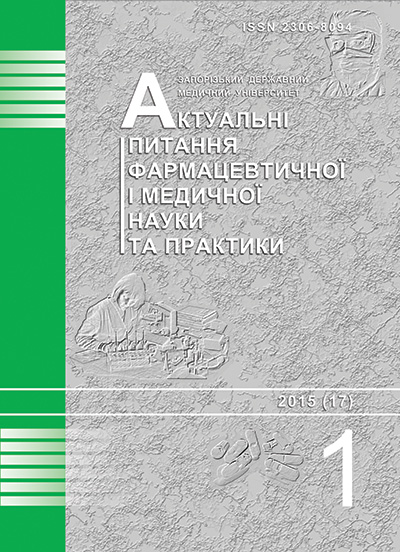Antitumour activity of 1,1-bis-(pyrimidine-2,4-diono-1-il)-2-bromo-2-chloroethylenes substituted molecular complexes and bacterial lectin
DOI:
https://doi.org/10.14739/2409-2932.2015.1.41341Keywords:
Pyrimidine, Antineoplastic Agents, LectinsAbstract
The aim of research. One of the most successful directions of new antitumour preparations finding is the investigation of antimetabolites of pyrimidin’s and purin’s change which forwards as preformed compounds at the link of biosynthetic processes (DNA, RNA, specific proteins) and brakes tumour’s growth. Molecular complexes on the base of 1,1-bis-[pyrimidine-2’,4’-diono-1’-il]-2-bromo-2’-chloroethylenes and bacterial lectin Bacillus polymyxa were produced with the purpose of new potential antitumour preparation’s obtaining. A purpose of the work is explaining of preformed heterocycles as pyrimidines, investigation of its antitumour activity. Molecular complexes of 1,1-bis-[pyrimidine-2’,4’-diono-1’-il]-2-bromo-2’-chloroethylenes and bacterial lectin Bacillus polymyxa were received.
Materials and methods. Objects of investigations are new bis-derivatives which were synthesised on the base of substituted pyrimidines and halothane. Investigation of critical toxicity of new compounds was carried out at Institute of Pharmacology and Toxicology of National Academy of Medical Sciences of Ukraine. The lectin’s preparations were obtained by treatment of culture Liquid of saprophytic strain Bacillus from Ukrainian Collection of Microorganisms of Institute of Microbiology and Virology (IMV): B. polymyxa 102 KGU; in future: lectine 102) clarified by treatment with ammonium sulfate (70% concentration of a saturated solution). The white imbredical mice and experimental model of tumor growth—cancer Limphosarcoma Plisa, published in Prozorovskiy (1978), were used. The experimental tumors used for our investigation were obtained from Strain Bank of Oncological Centre of Russian Academy of Medical Sciences. The experimental tumors were used for passage on experimental animals, and program freezing. Afterward, these would be preserved in Strain Bank of Institute of Pharmacology and Toxicology of National Academy of Medical Sciences of Ukraine. The quantity of animals in each group was six. Minimum weight of mice body was 17.0±2.0 g and 22,0±2,0 g, of rats body was 160,0+20,0 g. Percentage of primary recovery and destruction is “0.” Method of killing was decapitation and ethyl ester overdose. The method of the experimental tumors removal was surgery. There were six introductions of the physiological solutions of molecular complexes every day. The dosage of the preparations corresponded to 1/4-1/6 of the LD50. The efficiency parameter (% of tumor growth relaxation [volume and mass]) is > 50% in case of cancer Limphosarcoma Plisa. The main control data are: average weight of the tumor in the control animals (g), average weight of the tumor in experimental animals (g), % of growth relaxation of the tumor, index of effectiveness, and spleen ratio. The considerable criterion is > 50.0% of growth relaxation of the tumor. Preparation of standard was 5-flurouracil (5-FU). The results were assessed by standard methods of statistical analysis. Molecular complex of bis-adduct and bacterial lectin was obtained by mixing two components at physiological solution, 1:1.
Results. It was discovered that molecular complexes of bis-derivatives of pyrimidines and bacterial lectin apply little toxic preparations (LD50: from 338 mg/kg to 335 mg/kg). It has been established that molecular complexes of Bacillus polymyxa 102 KGU and bis-derivatives shows an anti-tumor activity on cancer Lymphosarcoma Plisa: 62,5% - 62.8% growth braking in cancer growth (considerable criteria is > 50.0% of tumor growth relaxation).
Conclusion. Anti-tumor activity of molecular complexes of Bacillus polymyxa 102 KGU and bis-derivative of pyrimidines permits us to consider it as physiological active with a perspective investigation as a potential antitumor drug for future treatment in people. The construction of the principle of new medical preparations, on the basis of the saprophytic strains bacterial lectins and heterocyclic bis-adducts, is very possible.
References
Adjei, A. A. (1999). Review of pharmacology and clinical activity of new chemotherapy agents for the treatment of colorectal cancer. Clinical Pharmacology, 48, 265–277. doi: 10.1046/j.1365-2125.1999.00010.x.
Anderson, N., & Lokich, J. (1992). Controversial issues in 5-fluorouracil infusion use. Dose intensity, treatment duration, and cost comparisons. Cancer, 70, 998–1002.
Anttila, M. I., Sotaniemi, E. A., Kairaluoma, M. I., Mokka, R. E., & Sundquist, H. T. (1983). Pharmacokinetics of ftorafur after intravenous and oral administration. Cancer Chemotherapy and Pharmacology, 10, 150–153.
Baba, H., Kohnoe, S., & Endo, K. (2000). State of the treatment for gastrointestinal cancer. Gan To Kagaku Ryoho, 27, 1233–1246.
Kovalenko, E. A. (1990). Vnekletochnye lektini bakterij [Extracellular bacterial lectins]. Mikrobiologicheskij zhurna, 5(3), 92–99. [in Ukrainian].
Prozorovskij, V. B., Prozorovskij, V. P. & Demchenko, V. М. (1978). Ekspress-metod opredeleniya srednej e`ffektivnosti dozy i ego oshibka [Express-method of middle effective dose determination and its mistake]. Farmakologiya i toksikologiya, 41(4), 407–509. [in Russian].
Gerus, I. I., Yagupol`skij, Yu. L., & Kukhar`, V. P. (1989). 1-Alkoksy(ariloksy)-1,1-diftor-2-chlor-2-brometany [1-Alkoxy(aryloxy)-1,1-difluoro-2-chloro-2-bromoetha-nes]. Zhurnal organicheskoj khimii, 25, 2020–2021. [in Russian].
Kleckij, M. E., Cupak, E. B. & Nazarov, D. A. (2002). Struktura i reakcionnaya sposobnost` proizvodnykh uratcila [Structure and reactive ability of derivatives of uracile]. Himiya geterociklicheskikh soedinenij, 8, 1106–1108. [in Latvia].
Blokhin, N. N., Perevodchikova, N. I. (1984). Khimioterapiya opukholevykh zabolevanij [Chemical therapy of cancer illness]. Moscow: Medicine. [in Russian].
Mashkovskij, M. D. (2006). Lekarstvennye sredstva [Medical preparations]. Мoscow: Novaya volna. [in Russian].
Downloads
How to Cite
Issue
Section
License
Authors who publish with this journal agree to the following terms:
Authors retain copyright and grant the journal right of first publication with the work simultaneously licensed under a Creative Commons Attribution License that allows others to share the work with an acknowledgement of the work's authorship and initial publication in this journal. 
Authors are able to enter into separate, additional contractual arrangements for the non-exclusive distribution of the journal's published version of the work (e.g., post it to an institutional repository or publish it in a book), with an acknowledgement of its initial publication in this journal.
Authors are permitted and encouraged to post their work online (e.g., in institutional repositories or on their website) prior to and during the submission process, as it can lead to productive exchanges, as well as earlier and greater citation of published work (See The Effect of Open Access)

